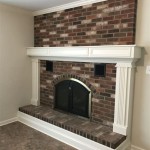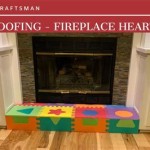Fireplace In Living Room Or Dining: A Focal Point Decision
The decision of whether to install a fireplace in a living room or a dining room is a complex one, influenced by factors ranging from architectural style to individual lifestyle preferences. A fireplace serves as more than just a heat source; it acts as a focal point, contributing significantly to the ambiance and overall aesthetic of a space. Therefore, careful consideration must be given to the specific characteristics and intended use of each room before making a final determination.
This article explores the merits of placing a fireplace in either the living room or the dining room, examining the practical, aesthetic, and potential drawbacks associated with each option. It will delve into how different types of fireplaces integrate into varying architectural designs and how the presence of a fireplace influences the activities and overall experience within each space. Understanding these aspects is crucial for homeowners seeking to enhance their homes with a functional and visually appealing fireplace.
The Living Room Fireplace: A Hub of Relaxation and Socialization
The living room, traditionally designed as a space for relaxation, entertainment, and social interaction, often benefits significantly from the presence of a fireplace. A fireplace can create a warm and inviting atmosphere, encouraging gatherings and fostering a sense of comfort and hospitality. The flickering flames and the radiant heat emanating from the fire offer a natural focal point for the room, drawing people together and creating a sense of intimacy.
From a design perspective, a fireplace in the living room can be incorporated into a variety of styles. In a traditional setting, a grand, ornate fireplace with a mantelpiece adorned with decorative objects can serve as a statement piece, reflecting a sense of elegance and history. In a more contemporary space, a sleek, minimalist fireplace with clean lines can provide a modern touch, complementing the room's understated aesthetic. The versatility of fireplace designs allows homeowners to seamlessly integrate them into existing décor or use them as a starting point for a complete redesign.
Furthermore, the integration of entertainment systems with a living room fireplace is a common practice. Many homeowners position televisions above the fireplace mantel, creating a single focal point that combines entertainment and warmth. However, careful consideration must be given to the height and viewing angle of the television to ensure optimal comfort. Alternative arrangements, such as placing the television to the side of the fireplace or utilizing a separate media center, may be more suitable depending on the room's layout and the homeowner's preferences.
The type of fireplace chosen for the living room also impacts the overall experience. Gas fireplaces offer convenience and ease of use, with instant ignition and adjustable flame settings. Wood-burning fireplaces, on the other hand, provide a more authentic and traditional feel, with the crackling sound and aroma of burning wood adding to the ambiance. Electric fireplaces offer a cost-effective and environmentally friendly alternative, providing realistic flame effects without the need for venting or fuel. The choice depends on individual priorities, including convenience, aesthetics, and environmental concerns.
Considerations regarding safety are paramount when installing a fireplace in the living room. Proper ventilation is essential, especially for wood-burning fireplaces, to prevent the buildup of harmful gases such as carbon monoxide. Regular chimney cleaning and maintenance are also crucial to ensure safe and efficient operation. Fire screens or glass doors can be used to prevent sparks from escaping and to protect children and pets from accidental burns.
The Dining Room Fireplace: Enhancing the Culinary Experience
While less common than in the living room, a fireplace in the dining room can offer a unique and sophisticated touch, elevating the dining experience and creating a memorable atmosphere for meals and gatherings. The presence of a fireplace can transform the dining room into a cozy and inviting space, perfect for intimate dinners or festive celebrations. The soft glow of the fire adds a touch of romance and elegance, enhancing the enjoyment of food and conversation.
The placement of a fireplace in the dining room requires careful consideration of the room's layout and dimensions. Ideally, the fireplace should be positioned in a way that does not interfere with the flow of traffic or the placement of furniture. A fireplace can be integrated into a wall, serving as a backdrop for the dining table, or it can be positioned in a corner, creating a cozy nook. The size and style of the fireplace should be proportionate to the size of the room, ensuring that it complements the overall aesthetic without overwhelming the space.
From a design perspective, a dining room fireplace can be incorporated into a variety of styles, ranging from traditional to modern. In a formal dining room, a grand fireplace with intricate detailing and a marble surround can create a sense of opulence and refinement. In a more casual dining room, a simpler fireplace with a rustic brick or stone finish can provide a warm and inviting touch. The fireplace mantel can be used to display decorative objects, such as candles, vases, or artwork, adding personality and character to the room.
Certain practical considerations must be addressed when incorporating a fireplace into the dining room. The heat generated by the fireplace can impact the temperature of the room, potentially making it too warm during summer months. Proper ventilation is essential to ensure that the room remains comfortable and that the air quality is maintained. The placement of the dining table should be carefully considered to ensure that it is not too close to the fireplace, preventing guests from feeling overheated.
The choice of fireplace type for the dining room is also an important consideration. Gas fireplaces offer convenience and ease of use, allowing for instant ignition and adjustable flame settings. Electric fireplaces provide a cost-effective and environmentally friendly alternative, offering realistic flame effects without the need for venting or fuel. Wood-burning fireplaces, while providing a more traditional and authentic feel, may not be the most practical option for the dining room due to the potential for smoke and soot.
Architectural Considerations and Fireplace Integration
The architectural style of the home plays a crucial role in determining the type and placement of a fireplace. In a traditional home with classic architectural features, a grand, ornate fireplace with a mantelpiece adorned with decorative objects can serve as a statement piece, reflecting a sense of history and elegance. These fireplaces often feature intricate carvings, elaborate moldings, and luxurious materials, such as marble or granite.
In a modern home with clean lines and minimalist design, a sleek, contemporary fireplace with a simple and understated aesthetic can provide a modern touch. These fireplaces often feature clean lines, geometric shapes, and minimalist materials, such as stainless steel or glass. The fireplace can be integrated into a wall, creating a seamless and integrated look, or it can be designed as a freestanding unit, serving as a focal point in the room.
For homes with a rustic or farmhouse aesthetic, a fireplace with a natural and organic feel can be the perfect addition. These fireplaces often feature rough-hewn stone, reclaimed wood, and exposed brick, creating a warm and inviting atmosphere. The fireplace can be designed as a large, imposing structure, serving as the centerpiece of the room, or it can be incorporated into a smaller, more intimate space, such as a reading nook or a cozy corner.
Regardless of the architectural style of the home, it is important to ensure that the fireplace is properly integrated into the overall design. The size, style, and placement of the fireplace should be proportionate to the size and dimensions of the room, ensuring that it complements the overall aesthetic without overwhelming the space. The fireplace surround and mantel should be chosen to match the existing décor, creating a cohesive and harmonious look.
Furthermore, the location of the fireplace needs to consider existing structural elements, such as load-bearing walls and chimney access. Installing a fireplace often requires modifications to the existing structure, which can be costly and time-consuming. Careful planning and consultation with a qualified contractor are essential to ensure that the installation is done safely and efficiently.
Beyond functional considerations, the aesthetic impact of the fireplace within the broader architectural context is crucial. A poorly placed or designed fireplace can clash with the existing design, detracting from the overall aesthetic appeal of the home. Conversely, a well-integrated fireplace can enhance the architectural features of the home, adding value and character to the space.
Ultimately, the decision of whether to install a fireplace in the living room or the dining room, and the specific type and design chosen, rests on a complex interplay of personal preferences, lifestyle considerations, and architectural constraints. By carefully evaluating these factors, homeowners can make informed decisions that enhance the beauty, comfort, and value of their homes.

21 Attractive Dining Room Fireplace Ideas For Pleasant Ambience Contemporary Winter Decor

23 Double Sided Fireplace Designs In The Living Room Home Design Lover With Family

Dining Room Fireplace Ideas For Romantic Winter Nights Decoist

Summer Preview Rugs For In Out Living Room Dining Combo

9 Fireplace Design Ideas From Candice Olson Living Room Dining Combo

75 Best Fireplace Ideas Designs In Every Style

Dining Room Fireplace Ideas For Romantic Winter Nights Decoist

11 Appealing Living Room Designs With A Fireplace

Living And Dining Room Renovation Divine Design

50 Cozy Fireplace Ideas Best Mantel Decor








